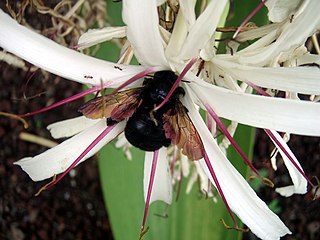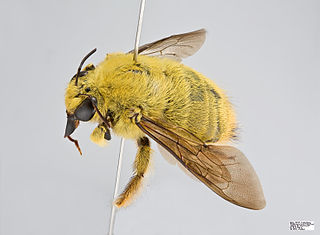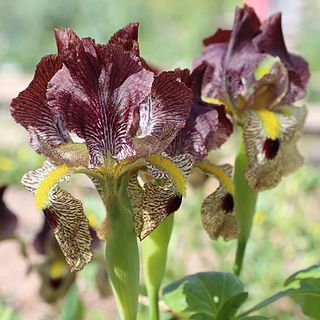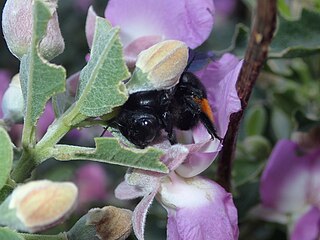
Carpenter bees are species in the genus Xylocopa of the subfamily Xylocopinae. The genus includes some 500 bees in 31 subgenera. The common name "carpenter bee" derives from their nesting behavior; nearly all species burrow into hard plant material such as dead wood or bamboo. The main exceptions are species in the subgenus Proxylocopa; they dig nesting tunnels in suitable soil.

Bee pollen is a ball or pellet of field-gathered flower pollen packed by worker honeybees, and used as the primary food source for the hive. It consists of simple sugars, protein, minerals and vitamins, fatty acids, and a small percentage of other components. Also called bee bread, or ambrosia, it is stored in brood cells, mixed with saliva, and sealed with a drop of honey. Bee pollen is harvested as food for humans and marketed as having various, but yet unproven, health benefits.

Xylocopa virginica, more commonly known as the eastern carpenter bee, extends through the eastern United States and into Canada. They nest in various types of wood and eat pollen and nectar. The eastern carpenter bee is similar to most other bee species in that it does not have a queen; in Xylocopa virginica, females are responsible for reproduction, foraging, and nest construction, though they may sometimes have help from their daughters. Xylocopa virginica is sympatric with Xylocopa micans in the southeastern United States.

Xylocopa violacea, the violet carpenter bee, is the common European species of carpenter bee, and one of the largest bees in Europe. It is also native to Asia.

Xylocopa sonorina, the valley carpenter bee or Hawaiian carpenter bee, is a species of carpenter bee found from western Texas to northern California, and the eastern Pacific islands. Females are black while males are golden-brown with green eyes.

The California carpenter bee, Xylocopa californica, is a species of carpenter bee in the order Hymenoptera. It is native to western North America.

Xylocopa valga is a species of carpenter bee common to: western, central and southern Europe, except for far northern latitudes; the Caucasus; Middle East; Central Asia; and Mongolia. The solitary bee has a black and blue coloured body, 20–27 mm in length, and densely covered with purple hairs. The small wings also have a purple tint. The bee creates cavity nests by gnawing the wood in the trunks of dead trees and in old wooden structures. It inhabits both forests and urban areas.

Xylocopa caffra is a species of Afrotropical carpenter bee that ranges from west to central and southern Africa, besides Madagascar and some Indian Ocean archipelagos.

Xylocopa caerulea, the blue carpenter bee, is a species of carpenter bee.

Xylocopa aestuans, or Xylocopa (Koptortosoma) aestuans, is a species of carpenter bee. It is widely distributed in Southeast Asia.
Xylocopa dejeanii, or Xylocopa (Zonohirsuta) dejeanii, is a species of carpenter bee. It is widely distributed in Asian countries.
Xylocopa ruficornis, or Xylocopa (Koptortosoma) ruficornis, is a species of carpenter bee. It is found in the Sri Lankan.

Xylocopa pubescens is a species of large carpenter bee. Females form nests by excavation with their mandibles, often in dead or soft wood. X. pubescens is commonly found in areas extending from India to Northeast and West Africa. It must reside in these warm climates because it requires a minimum ambient temperature of 18 degrees Celsius in order to forage.

Xylocopa micans, also known as the southern carpenter bee, is a species of bee within Xylocopa, the genus of carpenter bees. The southern carpenter bee can be found mainly in the coastal and gulf regions of the southeastern United States, as well as Mexico and Guatemala. Like all Xylocopa bees, X. micans bees excavate nests in woody plant material. However, unlike its sympatric species Xylocopa virginica, X. micans has not been found to construct nest galleries in structural timbers of building, making it less of an economic nuisance to humans. Carpenter bees have a wide range of mating strategies between different species. The southern carpenter bee exhibits a polymorphic mating strategy, with its preferred method of mating changing as the season progresses from early spring to mid summer. Like most bees in its genus, the southern carpenter bee is considered a solitary bee because it does not live in colonies.

Iris paradoxa is a species of flowering plant native to western Asia. It has large upright petals and smaller lower petals, which is unique amongst most iris forms. They come in various shades from white, lavender, mauve, medium purple, violet, dark purple to black. It has a black or purplish black beard on the lower petals. It comes from the region of Transcaucasia, and is found in the countries of Iran,, Turkey, Armenia and in Azerbaijan.

Xylocopa rufitarsis, the red-leg carpenter bee, is a species of carpenter bee native to South Africa. It has been assigned to the subgenus Xylomelissa. It was seen to visit flowers of a wide range of plants, many of them Fabaceae such as Acacia karroo, Aspalathus linearis, A. spinescens, Calpurnia glabrata, Lebeckia multiflora, Lebeckia sericea, peas and Tipuana tipu, but also Agave sp., Anchusa capensis, Hermannia gariepina, Lobostemon trichotomus, Moraea cookii, Populus sp., Prenia pallens, Zygophyllum morgsana, Salvia dentata and other Lamiaceae. Nests of been found in Metalasia muricata, Psoralea aphylla and Pinus sp. They are parasitized by Anthrax badius.

Xylocopa appendiculata is a species of carpenter bee in the family Apidae.

Xylocopa mexicanorum is a species of carpenter bee in the family Apidae. It is found in Central America and North America.

Xylocopa tabaniformis, the horsefly-like carpenter bee, is a species of carpenter bee in the family Apidae. It is found in Central America, North America, and South America.
















